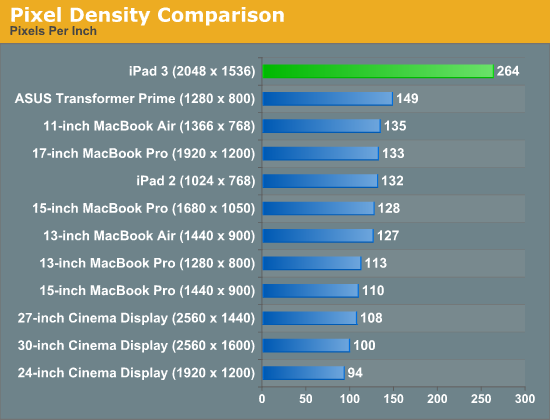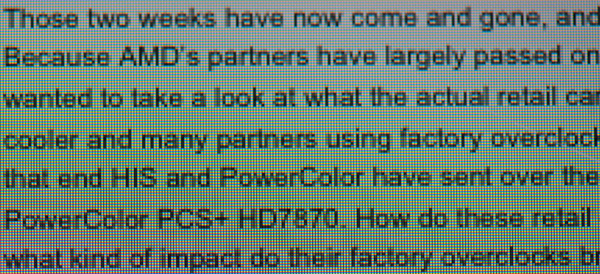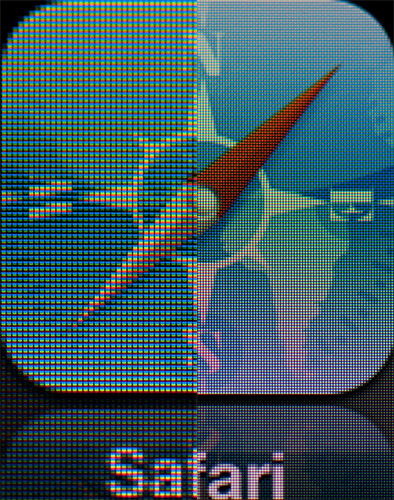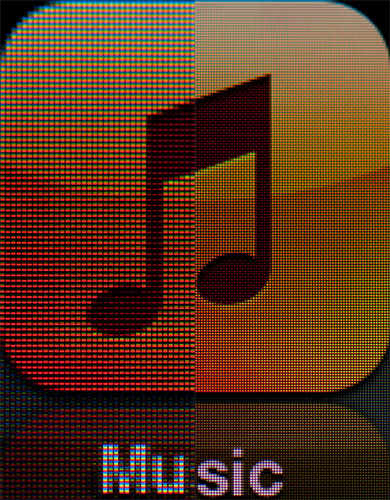The new iPad: Retina Display Analysis
by Anand Lal Shimpi on March 19, 2012 5:49 PM ESTWe're hard at work on our review on the new iPad but with a fair bit of display analysis under our belts I thought a quick post might be in order. One of the major features of the new iPad is its 2048 x 1536 Retina Display. Apple kept the dimensions of the display the same as the previous two iPad models, but doubled the horizontal and vertical resolution resulting in a 4x increase in pixels. As display size remained unchanged, pixel density went through the roof:

Although the iPad 2 has a fairly high pixel density compared to most of Apple's Mac/display lineup, you're more likely to hold a tablet closer to your eyes which made the low resolution/pixel density problematic. The new iPad addresses this issue as you can see from the chart above. I can't focus closely enough to the panel to actually make out pixels on the new iPad, much less at a normal viewing distance. With the aid of a macro lens we can definitely identify individual pixels. The improvement over the iPad 2 display is striking:
To the left we have the original 1024 x 768 panel, and to the right we have the new Retina Display. At this distance you can still identify individual pixels, an ability that quickly vanishes at normal viewing distances. The Music app icon is an even better example of what you gain from the newer display as it has more high contrast edges that appear more aliased on the 1024 x 768 panel:
The old iPad's 1024 x 768 resolution was fairly bothersome when it came to reading text on web pages or books. Most Android tablets standardizing on 1280 x 800 offered an advantage in that respect, albeit not delivering significantly higher pixel density. The new iPad completely resolves this issue. Hover over the links below to see roughly the same paragraph of text from our retail Radeon HD 7870 review on the iPad 2, new iPad and ASUS Transformer Prime:

| Apple iPad 2 | Apple iPad (3rd gen) | ASUS TF Prime |
| original | original | original |
While it's still obvious that you're looking at a screen and not an e-ink display, the pixels perform a good disappearing act on the new iPad.












172 Comments
View All Comments
andersenep - Wednesday, March 21, 2012 - link
Would you care to name a few of those apps?I'm not hating, I just honestly wonder what I am missing.
andersenep - Thursday, March 22, 2012 - link
So I just discovered Air Display. Second display for my MBA is pretty killer.SonicIce - Monday, March 19, 2012 - link
lol maco lens. 2nd paragraph. =)JSt0rm01 - Monday, March 19, 2012 - link
they really pwn in pixel density eh? :)mland550 - Monday, March 19, 2012 - link
There's a 40-or-so-page article on the macrumors forum comparing color temps between the new iPad and its predecessors/competitors. Many have commented on an off-white, yellowish screen at all brightness levels when displaying an all-white screen. Others still see a pinkish-toned screen. I am in that camp - When my iPad's screen displays white, it's not how I perceive the actual color - it's warmer and more pink.You mention in your post that the white balance of 6700 is the same as the iPad2's. Does this mean an all-white screen should appear the same on both panels? I admit the clarity of the display is amazing - but the color temperature, for me, is not. Moving from my desktop to my phone has never been as visually jarring as it is with the iPad - at first I thought it was the pixel density, but all my photos look exceptionally warm on the iPad. I would love to get your thoughts on what's happening here.
gorash - Tuesday, March 20, 2012 - link
I'd say, it still sucks. Bring on the OLED.tipoo - Tuesday, March 20, 2012 - link
I think OLEDS are still inferior in sunlight, but I haven't looked into it recently, did that change somehow? And while the black levels are great and the colours really pop out at you, some people find them too saturated and add artificial saturation where they shouldn't be. Personally I like them, but its not cut and dry that OLED is better. And its also interesting that Apple still leads in battery life despite using supposedly inferior LCds.Stas - Tuesday, March 20, 2012 - link
so Prime still has better screen? cool.TEAMSWITCHER - Tuesday, March 20, 2012 - link
Did you mouse over the captions beneath the TEXT sample bitmap at the bottom of the first page? You can see very clearly that the ASUS Transformer Prime has an inferior display. It's not even close!Stas - Wednesday, March 21, 2012 - link
Yes, I did, even though it wasn't working correctly. Obviously, there is more to the screen than resolution. And when resolution is high enough for me to not see the pixels (Prime) then I will take contrast and brightness over more pixels that I won't see anyway.